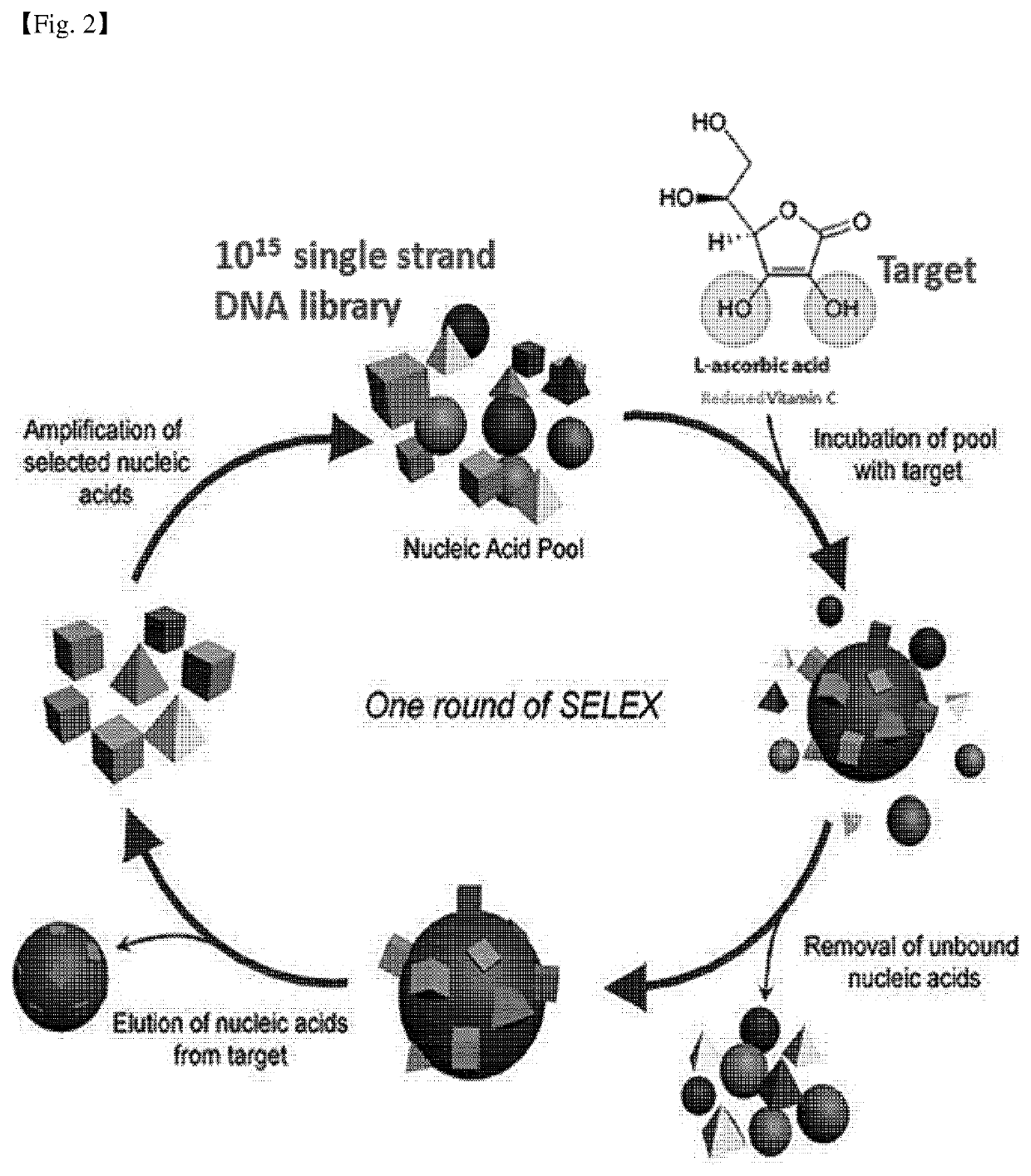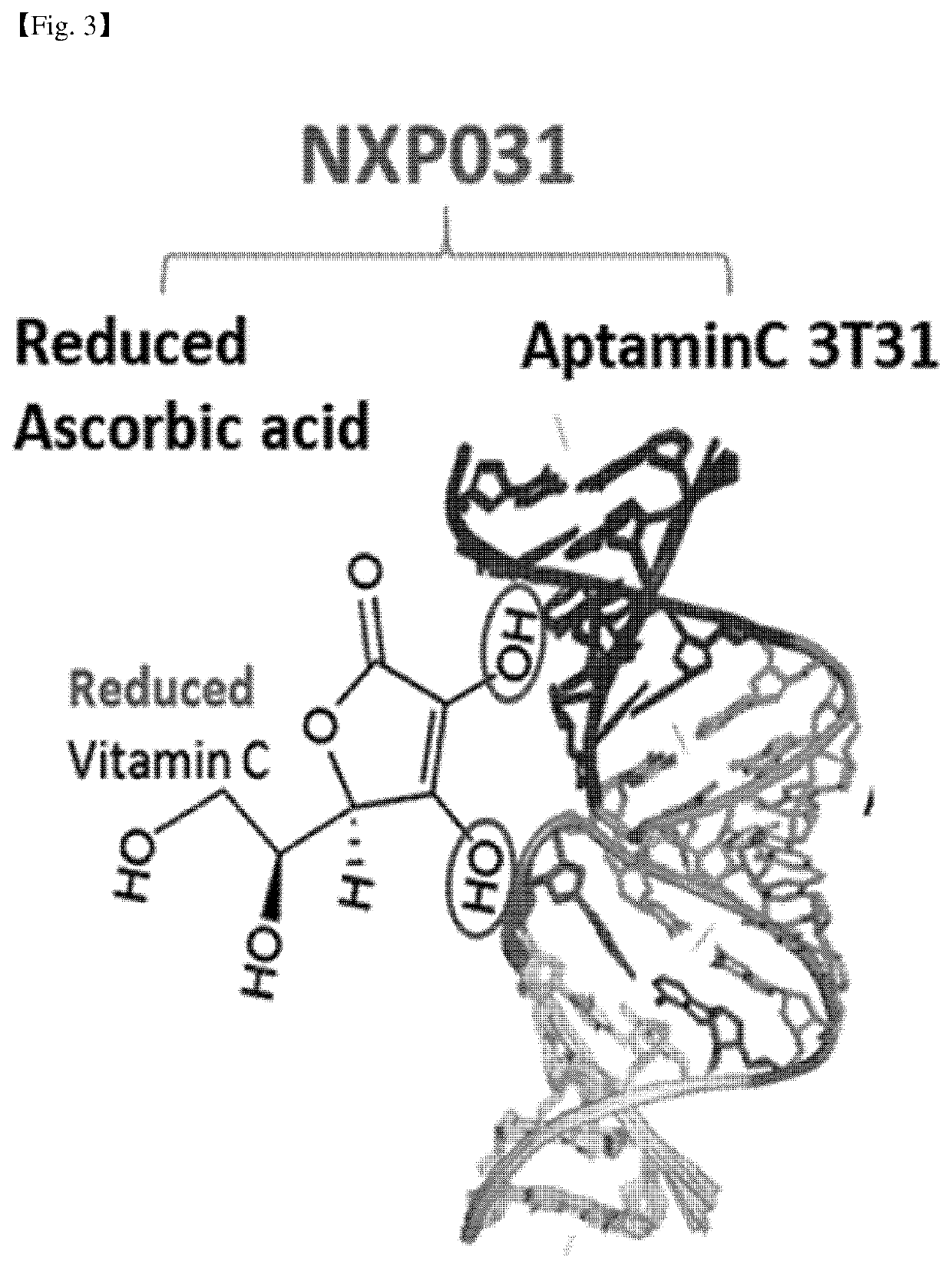Composition comprising aptamer as active ingredient for treatment and prevention of degenerative brain disease
a technology of brain disease and active ingredient, applied in the direction of drug composition, cardiovascular disorder, nervous disorder, etc., can solve the problems of lack of oxidative stress processing ability, low regenerative ability, and particularly susceptible brain to oxidative stress
- Summary
- Abstract
- Description
- Claims
- Application Information
AI Technical Summary
Benefits of technology
Problems solved by technology
Method used
Image
Examples
example 1
er Selection and Sequence Analysis
[0041]Ascorbic Acid SELEX:
[0042]9 rounds of SELEX for ascorbic acid were performed using a DNA library (BasePair Biotechnologies) consisting of ˜1015 unique oligonucleotides. The buffer composition used was as follows: 50 mM Sodium Acetate pH 5.5 (Sigma), 1 mM MgCl2 (Sigma), 0.05% Tween 20 (Sigma), 1% BSA (Sigma) and 1 mM glutathione (Sigma). The stringency of SELEX was changed by reducing the binding time of the aptamer to the target, changing the buffer composition, and reducing the concentration of the target in free molecule elution. Negative selection for DHA was performed to remove aptamers that bind to oxidized form of Ascorbic acid from the enriched library (FIG. 2).
[0043]Bioinformation analysis of the rich library produced by the SELEX method obtained candidate aptamers, and the ability to protect AA from oxidation from these top 20 was screened. The aptamer of SEQ ID NO: 1 showed the best effect.
example 2
: Fluorescence Analysis of Ascorbic acid Oxidation Products
[0044]with modifying e method described in Vislisel et al. (Vislisel, J. M., Schafer, F. Q. and Buettner, G. R. (2007) Analytical biochemistry, 365, 31-39). The oxidation of ascorbic acid was measured in reverse with detecting the oxidized product dehydroascorbic acid (DHA).
[0045]Briefly, aptamers were incubated with AA (10.3 μM) at 4× concentration for 30 minutes at room temperature before addition of 25 μM H2O2 (Sigma). Before the addition of OPDA dye (Sigma), the oxidizing agent sample was added and incubated at room temperature for 10 minutes. Immediately after addition of the dye (954.6 μM) sample, and read at excitation 345 nm; emission: 425 nm with a SpectraMax® plate reader (Molecular Devices) for 45 minutes at intervals of 60 seconds until the control converges. To confirm that the screening data shows AA protection and that there is no interference of oxidation products (DHA) or analytical dyes (OPDA), fluorescence...
example 3
Storage of Vitamin C by Aptamer
[0046]The aptamin C of the present invention was maintained at room temperature for 8 weeks and the reducing activity of ascorbic acid was measured using DCPIP (2,6-Dichlorophenolindophenol). As can be seen from FIG. 5, the aptamine C of the present invention inhibits the oxidation of ascorbic acid and maintains the reducing power, thereby increasing the shelf life by 4 times or more compared to the control group in which ascorbic acid alone exists.
PUM
| Property | Measurement | Unit |
|---|---|---|
| Ratio | aaaaa | aaaaa |
Abstract
Description
Claims
Application Information
 Login to View More
Login to View More - R&D
- Intellectual Property
- Life Sciences
- Materials
- Tech Scout
- Unparalleled Data Quality
- Higher Quality Content
- 60% Fewer Hallucinations
Browse by: Latest US Patents, China's latest patents, Technical Efficacy Thesaurus, Application Domain, Technology Topic, Popular Technical Reports.
© 2025 PatSnap. All rights reserved.Legal|Privacy policy|Modern Slavery Act Transparency Statement|Sitemap|About US| Contact US: help@patsnap.com



